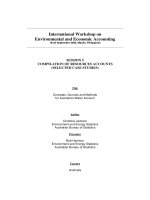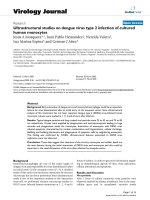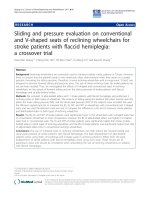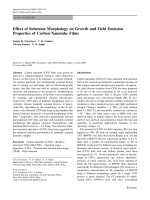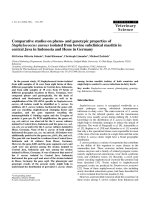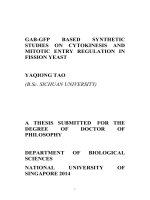Studies on genotypic and phenotypic correlation coefficient of different clones of eucalyptus (Eucalyptus tereticornis Sm)
Bạn đang xem bản rút gọn của tài liệu. Xem và tải ngay bản đầy đủ của tài liệu tại đây (237.63 KB, 5 trang )
Int.J.Curr.Microbiol.App.Sci (2018) 7(7): 3414-3418
International Journal of Current Microbiology and Applied Sciences
ISSN: 2319-7706 Volume 7 Number 07 (2018)
Journal homepage:
Original Research Article
/>
Studies on Genotypic and Phenotypic Correlation Coefficient of Different
Clones of Eucalyptus (Eucalyptus tereticornis Sm)
J.M. Bhatti1, Y.Y. Sumthane2*, A.U. Nimkar2, N. K. Kapse2 and Y.B. Tayde2
1
Department of Forestry, Dr. Panjabrao Deshmukh Krishi Vidyapeeth,
Akola (Maharashtra), India
2
Department of Forest Products, Dr. Y.S. Parmar University of Horticulture and Forestry,
Nauni (Solan) 173 230, H.P, India
*Corresponding author
ABSTRACT
Keywords
Correlation,
Coefficient,
Volume, Exhibited,
Phenotypic,
Genotypic
Article Info
Accepted:
24 June 2018
Available Online:
10 July 2018
In present investigation was carried out for better understanding of yield components
which helps to the tree breeder during indirect selection of plus trees from diverse
populations. Correlation simply measures the mutual relationship among volume and
volume contributing characters. The characters of Correlation coefficient parameters based
on plant height (m), girth (m), leaf area (m), dry weight of leaf (cm), number of branches.,
stem volume was recorded for all the clones under study exhibited the mean value of 0.17
m3 with a range of 0.13 to 0.21 m3. The highest value for the volume exhibited by clone
316 and 2030 (0.21 m3) followed by 07 (0.19 m3). Whereas, the lower magnitude for the
values of stem volume was recorded in for the clone 288 (0.13 m3) for getting better result
of correlation.
Introduction
Eucalyptus tereticornis has increasingly
become the most widely planted, hardwood
genus in the world (Turnbull, 1999).
Eucalyptus tereticornis provide sawn timber,
mine props, paper, pulp, fiber board, poles,
firewood, charcoal, essential oils, honey, and
tannin products. Eucalyptus tereticornis
plantation growth rate is an important
economic factor as fast growing trees will be
available for processing earlier compared to
slower growing trees. Tree growth and the
ultimate production of wood is a product of
the interaction of genetic, silvicultural and
environmental factors (Kozlowski and
Pallardy, 1997) (Pallett and Sale, 2004) (Drew
and Pammenter, 2006). The present status of
eucalyptus in India is, there are some 170
species, varieties and provenances of
eucalyptus were tried in India, out of which
the most outstanding and favoured has been
the E. hybrid, a form of E. tereticornis known
as Mysore gum.
In Maharashtra the Forest Department started
raising large scale plantations of eucalyptus
from 1961 onwards; over 150,000 ha of
3414
Int.J.Curr.Microbiol.App.Sci (2018) 7(7): 3414-3418
Eucalyptus plantations exist. The main species
raised are E. hybrid and E. camaldulensis in
the dry zone. In high rainfall areas Eucalyptus
grandis followed by E. robustaand Eucalyptus
saligna were found to be more suitable and in
Goa, Daman & Diu during since 1963, some
5,000 ha of Eucalyptus plantations were raised
to meet the shortage of fire wood. These
clones were grown by Industrial corridor to
utilize the pulp as a row material for paper
making. The climatic and geographic
conditions are satiable to this species in these
semi-arid climatic reasons.
Materials and Methods
The present investigation was carried out with
ten clones of Eucalyptus (Eucalyptus
tereticornis Sm.) at Department of Forestry,
Dr.Panjabrao Deshmukh KrishiVidyapeeth,
Akola and the observations were taken from
Eucalyptus clonal plantation in Yavatmal
district established by Ballarpur Paper
Industry Limited, Ballarpur, Maharashtra. The
clones under study belonging to same age
group. The soil of experimental site belongs to
red sandy and shallow black soil depth is up to
1 to 1.5m.
Climate and weather conditions
Eucalyptus clonal plantation in Yavatmal
district is situated at a distance of 3 Km from
Yavatmal in Eastern direction of YavatmalChandrapur Highway. The research station
falls under the agro-climatic zone number IX
north latitude at 20°24' N and 780 08’ E
longitude. The average range of temperature is
23.6°C to 38.6°C with mean annual rainfall of
886.4 mm.
Quantitative characters
The observations of quantitative characters
were recorded on one randomly selected plant
for each clone to representing treatment mean
for that replication. Plant height (m):Plant
height of randomly selected clone per
replication was recorded in meter by using the
altimeter. Girth (m): Girth of each clone was
recorded from 1.37 m above the ground level
at breast height in meter by using the
measuring tape. Leaf area (cm2):The leaves
from the plants are separated and grouped into
small, medium and large. One representative
leaf from each group is inserted in leaf area
meter. The instrument gives the direct leaf
area reading. From this reading the total leaf
area can be calculated. Dry weight of leaf
(g):Dry weight of leaf of each clone was
measured in hot air oven at the temperature of
80°for 4 hours in g. Number of
branches:Numbers of primary branches of
each clone were counted manually for each
clone per replication. Volume (m3):Volumeof
each genotype was calculated by using the
quarter girth formula given by Hoppu’s rule
(Chaturvedi et al., 1991).
Analysis of variance for various characters
The analysis of variance was carried out to test
the significance of difference between the
clones for the characters under study as per the
standard method given by Panse and
Sukhatme (1954) and Singh and Chaudhary
(1977).Based on above model, the table of
analysis of variance (ANOVA) was setup and
data was analysed. ‘F’ test was used to
measure the significance of the differences
among the clones. The standard error of
differences S.E. (d) and critical difference
(C.D.) between two means were also
calculated for treatment comparison.
Analysis of covariance
Fisher and Yates (1958) suggested a method
for partitioning the variance and covariance
into its
heritable
and non-heritable
components as per below.
3415
Int.J.Curr.Microbiol.App.Sci (2018) 7(7): 3414-3418
i) Genotypic variance
σ 2g
G.C.V.
Genotypic variance
X 100
X
P.C.V.
Phenotypic variance
X 100
X
MSg MS e
r
ii) Phenotypic variance
iii) Environmental variance
X = Mean of the character
σ 2p σ 2g MSe
G.C.V. = Genotypic coefficient of variation
P.C.V. = Phenotypic coefficient of variation
The genotypic, phenotypic and environmental
covariance’s were estimated on similar lines.
σ 2e MSe
Results and Discussion
Correlation
Variability parameters studies
It was estimated by the formula given by
Burton (1952)
The genotypic and phenotypic correlation,
correlation coefficient among the different
characters has been presented in Table 1.
Mean performance of eucalyptus clones for
selected quantitative traits.
Table.1 Genotypic and phenotypic correlation and correlation coefficient among the different
characters
Serial
Number
Treatments
(Clones)
Plant
girth
(m)
0.48
0.39
0.41
0.43
0.47
0.48
0.40
0.41
0.43
0.41
0.43
0.390.48
0.0194
7.8089
Leaf area
(cm2)
Se(m)
CV
Plant
height
(m)
14.21
13.52
14.06
14.65
14.17
14.90
14.31
14.75
14.13
14.72
14.34
13.5214.90
0.25016
3.O214
1
2
3
4
5
6
7
8
9
10
316
288
526
413
07
2030
415
2070
2130
411
Mean
Rang
Cd5%
0.7433
0.0576
5.22212
64.70
57.47
54.70
61.33
71.57
56.57
69.07
56.43
62.03
61.53
61.54
54.4771.57
1.75754
4.9466
3416
Dry weight
of
leaves
(g)
0.44
0.38
0.37
0.41
0.50
0.37
0.48
0.38
0.41
0.41
0.42
0.37-0.50
Number of Volume
branches
(m3)
13.33
13.67
11.00
12.33
13.33
13.67
13.33
12.67
14.00
13.33
13.07
11.00-14.00
0.21
0.13
0.15
0.17
0.19
0.21
0.15
0.16
0.16
0.15
0.17
0.13-0.20
0.01549
6.4382
0.40521
5.3713
0.01708
17.536
0.04602
1.20399
0.05074
Int.J.Curr.Microbiol.App.Sci (2018) 7(7): 3414-3418
Table.2 Analysis of variance of selected quantitative traits in eucalyptus
Sources of
variation
Degree
of
freedom
Plant
height
(m)
Girth
(m)
Leaf area
(cm2)
Dry
weight of
leaf (g)
Number
of
branches
Volume
(m3)
Replication
2
0.0872
0.0028
0.3906
0.00012
0.23333
0.00209
Treatment
9
0.5229*
0.0032*
93.885**
0.00632*
*
2.2814**
0.00233*
Error
18
0.1878
0.0011
9.266
0.00072
0.49259
0.00087
* Significant at 5 %
** Significant at 1 %
Table.3 Genotypic and phenotypic correlation coefficient (r)
Sr.
No.
Characters
Plant height (m)
1)
Girth (m)
2)
Leaf area (cm2)
3)
Dry weight of leaf (g)
4)
Number of branches
5)
Volume (m3)
6)
*
**
=
=
Girth
(m)
Leaf area
(cm2)
Dry weight
of leaf (g)
Number of
branches
Volume
(m3)
G
0.221
-0.142
-0.162
-0.041
0.340
P
0.399
-0.056
-0.075
-0.048
0.481
G
_
0.297
0.309
0.296
0.992
P
_
0.275
0.269
0.100
0.991
G
_
0.997
0.399
0.253
P
_
0.986
0.368
0.239
G
_
0.307
0.265
P
_
0.333
0.232
G
_
0.344
P
_
0.098
G
_
P
_
Significant at 5% level (361)
Significant at 1% level (463)
G
P
3417
= Genotypic correlation
= Phenotypic correlation
Int.J.Curr.Microbiol.App.Sci (2018) 7(7): 3414-3418
In conclusion, the genotypic and phenotypic
correlation coefficient studied between stem
volume and its contributing character
indicated that girth exhibited positive and
significant correlation with volume at
phenotypic and genotypic level (Table 2 and
3). The girth exhibited positive and nonsignificant correlation with dry weight of leaf
at genotypic and phenotypic level. Leaf area
showed exhibited positive and significant
correlation dry weight of leaf at genotypic and
phenotypic level. Dry weight of leaf exhibited
a positive and non-significant correlation with
number of branches at genotypic and
phenotypic level.
References
Burton GW. 1952. Quantitative in haritance
in grasses, Proc. 6th International
Grassland Congress. 1: 277-283.
Chaturvedi AN. and. KhannaLS. 1991. forest
mensuration.
International
Book
Distributors, DehraDun. pp 95-100.
Drew DM and Pammenter NW. 2006. Vessel
frequency, size and arrangement in
two eucalypt clones growing at sites
differing in water availability. New
Zealand Journal of Forestry 51:23-28.
Fisher RA and Yates F. 1958. Statistical
tables for biological, agricultural and
medical research. 5th edn. Hafner Publ.
Co., New York.
Kozlowski TT and Pallardy SG. 1997.
Physiology of Woody Plants. Second
edition. San Diego: Academic Press.
pp. 1-6.
Pallett RN and. Sale G. 2004.The relative
contributions of tree improvement and
cultural practice towards productivity
gains in Eucalyptus pulpwood stands.
Fort. Ecol. Manage. 193:33-43.
Panse VG. and Sukhatme PV. 1954.
Statistical methods for agricultural
workers, ICAR Publications. New
Delhi. pp 72-96.
Singh RK and ChaudharyBD. 1977.
Biometrical methods in quantitative
genetic analysis, Kalyani Publishers,
New Delhi. 200-223.
Turnbull JW. 1999. Eucalyptus plantations.
New Forests. 17:37-52.
How to cite this article:
Bhatti, J.M., Y.Y. Sumthane, A.U. Nimkar, N. K. Kapse and Tayde, Y. B. 2018. Studies on
Genotypic and Phenotypic Correlation Coefficient of Different Clones of Eucalyptus
(Eucalyptus tereticornis Sm). Int.J.Curr.Microbiol.App.Sci. 7(07): 3414-3418.
doi: />
3418
